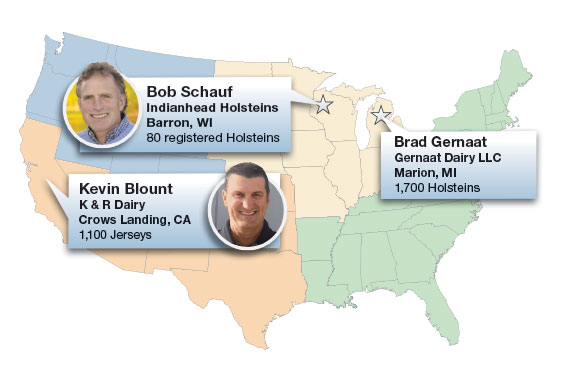Producers share best practices for quality corn silage Quality corn silage is essential to efficient milk production and overall herd health. Three dairy producers who rely on corn silage in their operations discuss their strategies for managing the feed that directly affects their bottom line.

Panelists are:
• Kevin Blount, K & R Dairy, Crows Landing, California; 1,100 Jerseys
• Brad Gernaat, Gernaat Dairy LLC, Marion, Michigan; 1,700 Holsteins
• Bob Schauf, Indianhead Holsteins, Barron, Wisconsin; 80 registered Holsteins

How much corn silage do you feed and what other ingredients make up your milking cow ration?
Blount: We feed 41 pounds of corn silage per cow on average. Our operation moved away from alfalfa completely nine years ago. It was costly to produce hay, and we felt the digestibility was too variable to make it a reliable feed. We also incorporate corn, canola, cottonseed, AminoPlus and straw into our ration.
Gernaat: As managers, we’ve decided that corn silage works best for our operation, and we push as much of it as possible. We strive for 21 to 25 pounds of corn silage per cow per day in addition to grass hay, commodities and beet pulp. We like the consistency of corn silage for mixing and feeding.
Schauf: Over the years, we have greatly increased the amount of corn silage and now feed 25 pounds per cow per day. We also feed roasted soybeans we grow ourselves and canola meal we produce with our on-farm oil pressing operation. In addition, the cows still get alfalfa and have access to dry hay when they’re outside.

How does feeding quality corn silage affect the overall success of your dairy?
Blount: Corn silage quality is one of the biggest factors affecting milk production on our dairy. When the quality isn’t there, we lose milk and have to spend more money on feed. We’ve worked hard to attain higher digestibility in our corn silage to maximize our efficiency.
Gernaat: Corn silage quality directly affects the bottom line. When making silage decisions, we watch the cows – how they’re milking, how they’re utilizing the feed and how they’re feeling. If we start with great forage, we have to put a lot less grain and other ingredients into the ration to make it work for our cows.
Schauf: There’s no question in my mind that silage quality is crucial to herd performance. Quality corn silage allows us to produce a high amount of milk at the lowest possible cost. Corn hybrids have improved in agronomic characteristics and nutritional value, making it easier for us to produce quality silage.

How has your use of corn silage changed in recent years?
Blount: I always say dairy producers must be willing to change. We’ll research whatever it takes to make the highest-quality silage and do everything in our power to provide our cows with the best possible feed. Our biggest change is trying brown midrib (BMR) corn silage to improve digestibility and dry matter intake (DMI). We know it’s working for our operation because we can see that our cows are healthier and there is more milk in the bulk tank.
Gernaat: We keep increasing our corn silage acres each year simply because we get more tons per acre than any other roughage. The more corn silage we feed, the better the cows do, so we keep feeding more.
Schauf: At one time, we fed all haylage, but we were looking for a way to increase DMI. I started reading up on corn silage and all signs pointed to greater palatability over haylage. The cows loved it, and we saw an increase in DMI right away. We also tried BMR corn silage when it was introduced because of the higher digestibility.
We saw an increase in milk production, so we’ve continually increased our use of BMR. In fact, last year, we ran out of our BMR corn silage and had to feed conventional silage. We saw an immediate five-pound to six-pound drop in production per cow. There is no question that BMR makes a difference.

What unique situations have you encountered on your operation?
Blount: In our area, water management is one of our biggest concerns when producing quality corn silage. We have to be very water-conscious, as it seems the hybrids perform better if they have adequate moisture.
Gernaat: We try to produce a quality product in the most efficient manner, using our land base and resources. Raising our own forages puts us in the driver’s seat and saves us money in the long run. The more high-quality corn silage I can grow, the less I have to supplement with purchased grain.
Schauf: Four or five years ago, I began reading about kernel processing and decided to try it. Digestibility has definitely improved since we incorporated kernel processing. We know the cows are using the silage more efficiently because there are fewer kernels in the manure.

How do you utilize forage testing in your corn silage feeding program?
Blount: We send our corn silage to Cumberland Valley Analytical Services , and we test for everything we can. We look at 30-hour neutral detergent fiber digestibility and obtain levels of protein, fiber, nonfiber, minerals, energy, pH and BFA. Once we’ve tested, results go to our nutritionist to help us balance our ration.
Gernaat: We frequently test our silage to keep track of how it’s performing throughout the season. Then we watch the cows. If they drop off in production or intake, we look at our ration and evaluate what needs to be adjusted. We also look at what we can do next year to make better silage.
Schauf: Forage analysis not only helps us balance our ration but also tells us if what we’re doing is working. If we’re unhappy with our forage, we make adjustments to next year’s crop – that could mean investigating a different hybrid, adjusting the moisture at which we harvest or incorporating kernel processing into our harvest plan. PD





